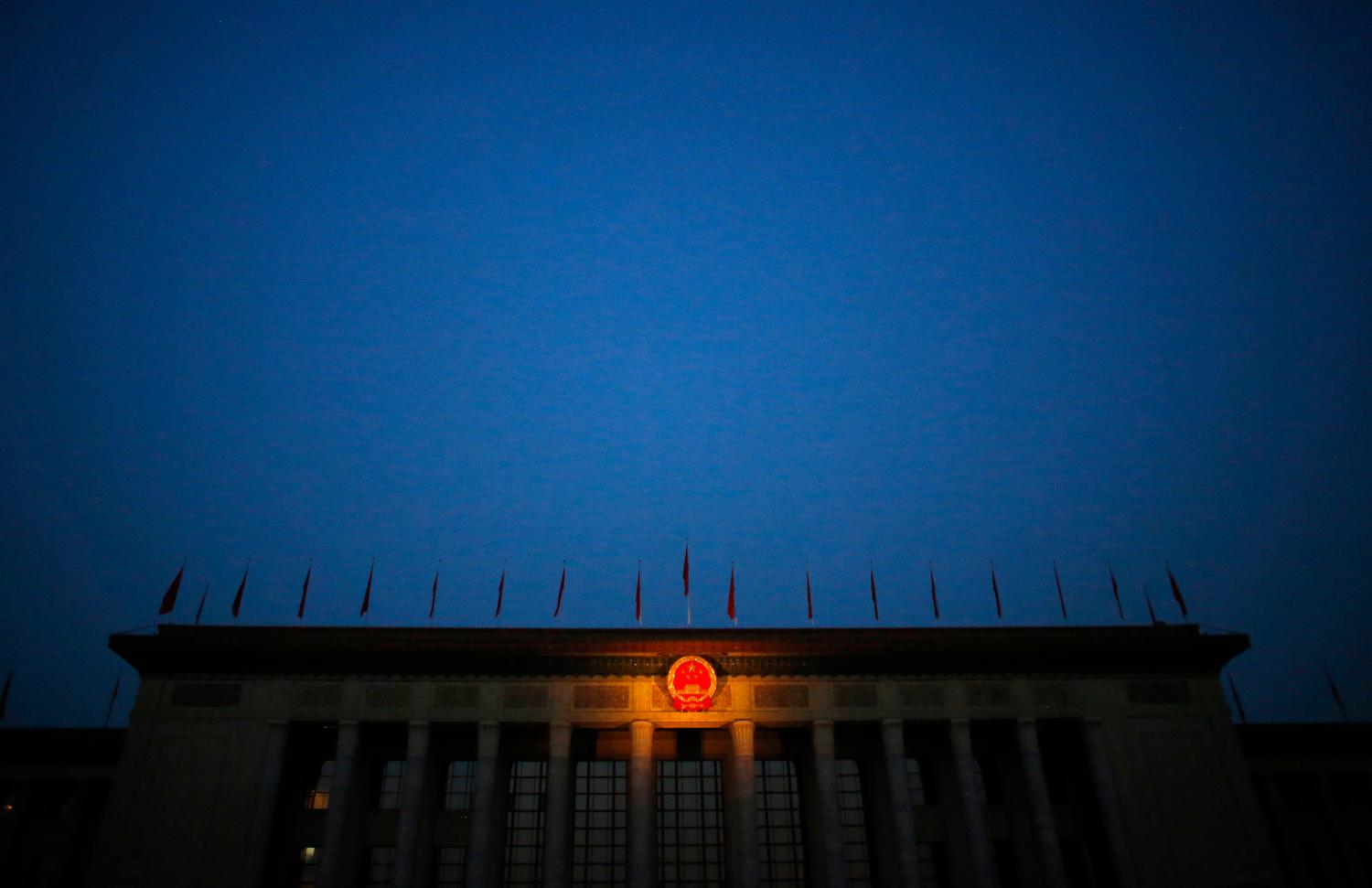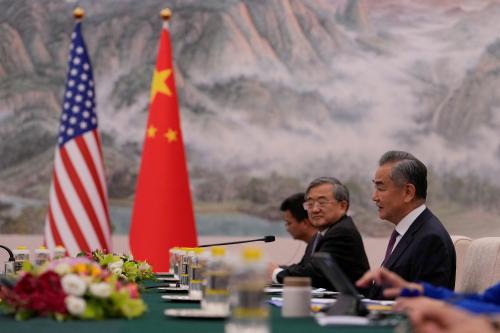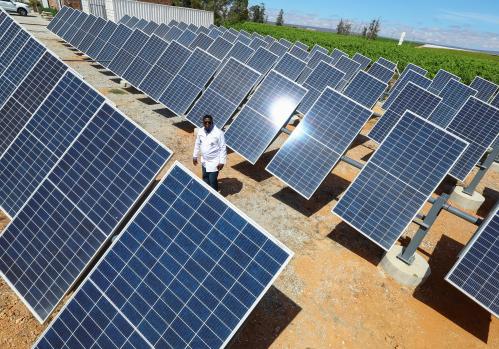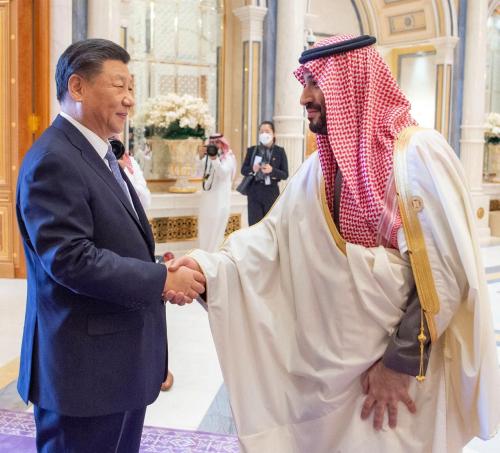 China has become the center of gravity for global energy markets. While energy demand growth has slowed or stopped in the Organisation for Economic Co-operation and Development (OECD) countries, China’s primary energy demand increased by more than 45% over the last decade.1 Going forward, the question is whether such growth will continue and how China’s energy system will change in response to the dual challenges of climate change and local pollution.
China has become the center of gravity for global energy markets. While energy demand growth has slowed or stopped in the Organisation for Economic Co-operation and Development (OECD) countries, China’s primary energy demand increased by more than 45% over the last decade.1 Going forward, the question is whether such growth will continue and how China’s energy system will change in response to the dual challenges of climate change and local pollution.
China is highly dependent on fossil fuel imports. It is the world’s largest importer of oil and natural gas2 and is an important coal importer as well. At the same time, China is striving to lead in new energy technologies, particularly wind and solar electricity generation and electric vehicles. To understand how China fits into energy markets and how energy shapes its policy, examining the electricity and oil and gas industries separately is illustrative. China is more in charge of its own fate in electricity, while it remains highly vulnerable to market conditions and supply shocks in oil and gas.
Electricity
As a result of rapid economic growth, demand for electricity in China in 2019 was more than five times its level in 2000. Demand growth slowed slightly in the last decade, but still averaged about 7% per year.3 As a result, China has added vast generation capacity of every type.
Coal still dominates the Chinese power sector, although its share of generation dropped from its high point of 81% in 2007 to 66% in 2019.4 During the decade from 2000-2019, China added 493 gigawatts of coal-fired generation capacity.5 Natural gas generation has also grown rapidly since 2014, but from a much smaller base, and reached 3.2% of Chinese power generation in 2019.6
Coal additions were particularly rapid during the 12th Five-Year Plan, from 2011 through 2015, as China encouraged the construction of coal-fired power plants to stimulate growth as the economy recovered from the global financial crisis. However, this situation led to overcapacity, and the subsequent 13th Five-Year Plan, for 2016 through 2020, aimed to contain growth in coal-fired power.7 Nonetheless, China is still experiencing overcapacity of coal-fired generation, with its plants running at less than 50% of capacity on average in 2019.8
The upcoming 14th Five-Year Plan, for 2021 through 2025, will be a key document in mapping the future of China’s electricity system. China’s Nationally Determined Contribution (NDC) under the Paris Agreement calls for its greenhouse gas emissions to peak no later than 2030. However, the behemoth State Grid Corporation and the China Electricity Council are both pushing for inclusion of more coal-fired power in the new plan, in part to encourage economic recovery from the COVID-19 pandemic.9 Building more coal, even the most efficient ultra-supercritical plants, is not consistent with China meeting its NDC, and certainly not consistent with the world’s overall climate goals.
As demand for new coal-fired power plants has declined in China, the country is financing and building significant new capacity abroad…
As demand for new coal-fired power plants has declined in China, the country is financing and building significant new capacity abroad, particularly through the Belt and Road Initiative (BRI). As of 2017, China had committed to or offered financing for more than one-quarter of the world’s coal-fired capacity being built outside of China, often with Chinese companies as the engineering, procurement, and construction contractors.10 Additionally, 23% of these projects are for subcritical technology, the least advanced and most polluting form of coal-fired generation.11 China is becoming the lender of last resort for coal-fired generation, as many international banks are no longer financing coal-fired power projects.12 An important goal of financing these projects abroad is to keep excess Chinese industrial capacity working.
However, BRI also raises concerns about “white elephant” projects and debt traps in countries that can scarcely afford them. Construction of coal-fired power capacity is no exception. For example, plans for a 6.6 gigawatt coal-fired power plant in Egypt were postponed indefinitely because of concerns about over-capacity and a growing preference for renewable electricity.13 Similar concerns have been expressed about planned facilities in Pakistan and Bangladesh as power demand falls due to the COVID-19 pandemic, but so far these projects are still going forward, despite overcapacity in power generation.14
The rapid growth in China’s renewable energy sector also gets a lot of attention, and rightly so. Over the last decade, China added 36% of the world’s total new renewable (wind and solar) generation capacity. At their peak in 2017, wind and solar capacity additions in China were 45% of the global total. Despite these vast additions, in 2019 wind and solar together still made up less than 10% of China’s power generation, with wind at 5.5% and solar at 3.0%.15
Despite its world-leading pace of wind and solar additions, China has faced challenges in integrating that power into its grid. The lack of long-distance, high-voltage transmission capacity results in significant amounts of wind and solar power being curtailed, meaning that it is generated without being used. The situation is improving, with wind and solar curtailment falling from 17% in 2016 to 7% in 2018.16 Excessive curtailment led China’s National Energy Agency in 2019 to halt new solar development in Gansu, Xinjiang, and Tibet provinces.17 Many large renewable projects are located in these remote regions, where there is less competition for land. However, greater transmission capacity and rules to ease power trading between provinces and prioritize renewable power in dispatch will be needed to fully take advantage of their resources.
Additionally, subsidies for renewable energy are being phased out. China is cutting its feed-in-tariff for solar power in half, is eliminating subsidies for offshore wind in 2020, and plans to end subsidies for onshore wind in 2021.18 Rapidly falling costs for wind and solar mean that new installations can compete with coal- and gas-fired power generation.
China has become a world leader in manufacturing for wind and solar equipment. It especially dominates the solar photovoltaic (PV) sector, with seven of the top 10 solar manufacturers globally in 2019.19 China is less dominant in wind turbine manufacturing, in part, because the large blades of turbines are often manufactured close to where they are installed. The wind industry is more geographically dispersed, with top-10 manufacturers in Europe, the United States, India, and China.20 One tends to think of China as a location for renewable energy manufacturing, but China also leads the world in renewable energy patents since 2000. Renewable energy is an industrial priority for President Xi Jinping and is included in the 13th Five-Year Plan as a “Strategic Emerging Industry.”21
Oil and gas
Unlike in electricity, where China is a technology leader, China is dependent on imports for its oil and gas supply. China has been a net oil importer since 1993 and became the world’s largest oil importer in 2017. Most of China’s oil production takes place in aging fields with high production costs.22 Although production increased by about 100,000 barrels per day in 2019,23 this production rise, and Chinese production in general, is unlikely to be profitable in today’s oil price environment, especially with the very low prices brought on by the COVID-19 pandemic.
From the early 2000s until about 2015, China’s oil companies focused on acquiring production assets abroad, concerned about meeting the country’s insatiable thirst for oil. However, more recent years have brought lower prices, well-supplied markets, and less concern about scarcity in light of the huge production boom in the United States. Today, China’s oil companies are more comfortable buying oil on the market, rather than buying oil-producing assets abroad.
More than half of China’s oil imports come from Organization of the Petroleum Exporting Countries (OPEC) countries and China has been the focus of global oil demand growth in the past decade. The Middle East dominates Chinese oil supply, as a region, but Russia is the country’s single largest supplier.24 As demand is flat-to-declining in the OECD countries and oil production in the United States has taken off, China and the rest of developing Asia has become the market of choice for oil producers around the world.
China’s appetite for natural gas grew rapidly over the last decade, much faster than its domestic production capacity, as gas use increased in the industrial and power generation sectors. China has thus become an important importer of gas as well, with imports making up 45% of China’s natural gas supply in 2018, an increase from 15% in 2010.25 China is now the world’s largest importer of natural gas,26 with 36% of that gas coming through pipelines and 64% imported as liquified natural gas (LNG) in 2019.27
Australia and Qatar together supply about 60% of China’s LNG, with Malaysia, Indonesia, Papua New Guinea, and the United States as other significant players. China’s pipeline gas has historically come almost entirely from Central Asia: Turkmenistan, Uzbekistan, and Kazakhstan. However, the balance in China’s natural gas market is changing fast, as the Power of Siberia pipeline from Russia delivered its first gas at the end of 2019.28 This pipeline will deliver 38 billion cubic meters of gas annually, an 80% increase in pipeline gas supply.
Energy concerns influence Chinese geopolitics
Securing its oil and gas supply is a key goal of China’s trade relationships. This has been a two-way street in recent years, as oil- and gas-producing countries become concerned about security of demand for their products, in a world of growing concern about climate change and flattening OECD demand. As a result, China’s relationships with key energy producers, especially the Gulf OPEC producers and Russia, have become broader and deeper in recent years.
At the Third High-level Meeting of the OPEC-China Energy Dialogue in October 2019, the parties agreed to strengthen cooperation and to collaborate on future market outlooks.29 Saudi Arabia, in particular, has been investing in Chinese refining and petrochemical complexes to ensure a market for its oil.30 The Abu Dhabi National Oil Company and the China National Offshore Oil Corporation signed an agreement in 2019 to explore opportunities and share expertise in upstream and downstream oil and LNG.31 In return, China is investing in the Gulf States, in oil and gas projects32 and in infrastructure through BRI.33 China has also pledged $23 billion in loans and development aid to the region through the China-Arab States Cooperation Forum.34
Russia is pursuing similar cooperative relationships with China, as Russia seeks to secure market share and China seeks to ensure reliable oil and gas supply. However, the relationship includes less mutual investment than China’s relationship with the OPEC producers. At the St. Petersburg International Economic Forum in June 2019, Rosneft Chief Executive Officer Igor Sechin, a close ally of President Vladimir Putin, said, “Russia-China cooperation can become a significant force to stabilize energy markets. We can conduct a joint balanced energy policy, in our own interests and in the interests of our partners.”35 The two countries are also discussing trading energy products in yuan or rubles instead of the ubiquitous U.S. dollar to avoid the U.S. financial system and U.S. sanctions.36 The new Power of Siberia natural gas pipeline ushers in a new era of gas trade between the countries, aiding Russia in developing its Far East and China in transitioning its industrial northeast from coal to gas.37
China’s focus on renewable energy also has geopolitical implications. China is acutely aware of its vulnerability as a significant energy importer, but its focus on renewable energy and electric vehicles aims to make it a supplier of the energy forms of the future, rather than an importer. Additionally, China’s focus on electric vehicles can allow it to rely on local renewable and coal-fired electricity to fuel its transportation sector, rather than imported oil, potentially improving its balance of trade and better insulating its economy from fuel price fluctuations. Unlike its current energy partners in the Gulf States and Russia, China stands to gain from the transition to greener, low-carbon forms of energy. However, the Chinese economy has a long way to go to reduce its dependence on imported oil, and thus will continue its quest to ensure supply security.
-
Footnotes
- “Statistical Review of World Energy 2020,” (London: BP, 2020), https://www.bp.com/content/dam/bp/business-sites/en/global/corporate/pdfs/energy-economics/statistical-review/bp-stats-review-2020-full-report.pdf.
- Jude Clement, “China Is The World’s Largest Oil & Gas Importer,” Forbes, October 17, 2019, https://www.forbes.com/sites/judeclemente/2019/10/17/china-is-the-worlds-largest-oil–gas-importer/.
- “Statistical Review of World Energy 2020,” BP.
- “Statistical Review of World Energy 2020,” BP.
- Lauri Myllyvirta, Shuwei Zhang, and Xinyi Shen, “Analysis: Will China build hundreds of new coal plants in the 2020s?” Carbon Brief, March 24, 2020, https://www.carbonbrief.org/analysis-will-china-build-hundreds-of-new-coal-plants-in-the-2020s.
- “Statistical Review of World Energy 2020,” BP.
- Jorrit Gosens, Tomas Kaberger, and Yufei Wang, “China’s next renewable energy revolution: goals and mechanisms in the 13th Five Year Plan for energy,” Energy Science & Engineering 5, no. 3 (May 2017): 141-155, https://onlinelibrary.wiley.com/doi/epdf/10.1002/ese3.161.
- Lauri Myllyvirta, Shuwei Zhang, and Xinyi Shen, “Analysis: Will China build hundreds of new coal plants in the 2020s?”
- Ibid.
- Christine Shearer, Melissa Brown, and Tim Buckley, “China at a Crossroads: Continued Support for Coal Power Erodes Country’s Clean Energy Leadership,“ (Lakewood, OH: Institute for Energy Economics and Financial Analysis, January 2019), https://ieefa.org/wp-content/uploads/2019/01/China-at-a-Crossroads_January-2019.pdf.
- Christine Shearer, Melissa Brown, and Tim Buckley, “China at a Crossroads.”
- Tim Buckley, “Over 100 Global Financial Institutions Are Exiting Coal, With More to Come,“ (Lakewood, OH: Institute for Energy Economics and Financial Analysis, February 27, 2019), http://ieefa.org/wp-content/uploads/2019/02/IEEFA-Report_100-and-counting_Coal-Exit_Feb-2019.pdf.
- Simon Nicholas, “Fate of Egypt’s coal-fired project a sign of greener times,” BusinessDay, April 16, 2020, https://www.businesslive.co.za/bd/opinion/2020-04-16-fate-of-egypts-coal-fired-project-a-sign-of-greener-times/.
- Simon Nicholas, “Shelving of huge BRI coal plant highlights overcapacity risk in Pakistan and Bangladesh,” China Dialogue, May 1, 2020, https://chinadialogue.net/en/energy/11988-shelving-of-huge-bri-coal-plant-highlights-overcapacity-risk-in-pakistan-and-bangladesh/.
- “Statistical Review of World Energy 2020,” BP.
- Michael Standaert, “Why China’s Renewable Energy Transition Is Losing Momentum,” YaleEnvironment360, September 26, 2019, https://e360.yale.edu/features/why-chinas-renewable-energy-transition-is-losing-momentum.
- David Stanway, “China blocks new solar in 3 NW regions amid overcapacity fears,” Reuters, February 14, 2019, https://www.reuters.com/article/us-china-solarpower/china-blocks-new-solar-in-3-nw-regions-amid-overcapacity-fears-idUSKCN1Q404G.
- Chen Xuewan and Lu Yutong, “China to Slash Subsidies for Renewable Energy,” Sixth Tone, May 12, 2020, https://www.sixthtone.com/news/1005309/china-to-slash-subsidies-for-renewable-energy.
- “Top 10 Solar Energy Companies in the World 2019,” Technavio, May 9, 2019, https://blog.technavio.com/blog/top-10-solar-energy-companies.
- ”Top ten wind turbine suppliers,” Energy Digital, April 10, 2015, https://www.energydigital.com/top-10/top-10-wind-turbine-suppliers.
- “The 13th Five-Year Plan for Economic and Social Development of the People’s Republic of China,” (Beijing: Central Committee of the Communist Party of China, 2016), https://en.ndrc.gov.cn/policyrelease_8233/201612/P020191101482242850325.pdf.
- Samantha Gross, “Lower for longer: The implications of low oil and gas prices for China and India,” (Washington, DC: The Brookings Institution, October 2017), https://www.brookings.edu/research/lower-for-longer-the-implications-of-low-oil-and-gas-prices-for-china-and-india/.
- Jeff Barron, “China’s crude oil imports surpassed 10 million barrels per day in 2019,” U.S. Energy Information Administration, March 23, 2020, https://www.eia.gov/todayinenergy/detail.php?id=43216.
- “Statistical Review of World Energy 2020,” BP.
- Faouzi Aloulou and Victoria Zaretskaya, “China adds incentives for domestic natural gas production as imports increase,” U.S. Energy Information Administration, October 23, 2019, https://www.eia.gov/todayinenergy/detail.php?id=41773.
- “Natural Gas Information 2019,” (Paris: International Energy Administration, September 17, 2019), https://webstore.iea.org/natural-gas-information-2019.
- “Statistical Review of World Energy 2020,” BP.
- Anna Galtsova and Jenny Yang, “The era of Russian pipeline gas supply to China begins,” IHS Markit, December 2, 2019, https://ihsmarkit.com/research-analysis/the-era-of-russian-pipeline-gas-supply-to-china-begins.html.
- “Third High-level Meeting of the OPEC-China Energy Dialogue,” Organization of the Petroleum Importing Countries, October 21, 2019, https://www.opec.org/opec_web/en/press_room/5720.htm.
- “Saudi Aramco boosts ties with China,” The Economist Intelligence Unit, November 12, 2018, http://www.eiu.com/industry/article/1718678555/saudi-aramco-boosts-ties-with-china/2019-11-12.
- Varun Godinho, “UAE and China sign strategic oil and gas agreement,” Gulf Business, July 22, 2019, https://gulfbusiness.com/uae-china-sign-strategic-oil-agreement/.
- James Murray, “China leads investment for Middle East oil and gas projects worth $75bn,” NS Energy, November 21, 2019, https://www.nsenergybusiness.com/features/china-oil-and-gas-investment/.
- Jonathan Fulton, “China’s Gulf Investments Reveal Regional Strategy,” The Arab Gulf States Institute in Washington, July 29, 2020, https://agsiw.org/chinas-gulf-investments-reveal-regional-strategy/.
- James Murray, “China leads investment for Middle East oil and gas projects worth $75bn.”
- Nadia Rodova, Herman Wang, and Rosemary Griffin, “More Russia, China oil trade can set new markers, influence prices: Rosneft CEO,” S&P Global, June 6, 2019, https://www.spglobal.com/platts/en/market-insights/latest-news/oil/060619-more-russia-china-oil-trade-can-set-new-markers-influence-prices-rosneft-ceo.
- Nadia Rodova, Herman Wang, and Rosemary Griffin, “More Russia, China oil trade can set new markers, influence prices: Rosneft CEO.”
- Eleanor Albert, “China’s Neighborhood Energy Alternative,” The Diplomat, December 6, 2019, https://thediplomat.com/2019/12/russia-chinas-neighborhood-energy-alternative/.
The Brookings Institution is committed to quality, independence, and impact.
We are supported by a diverse array of funders. In line with our values and policies, each Brookings publication represents the sole views of its author(s).





Commentary
The global energy trade’s new center of gravity
September 14, 2020